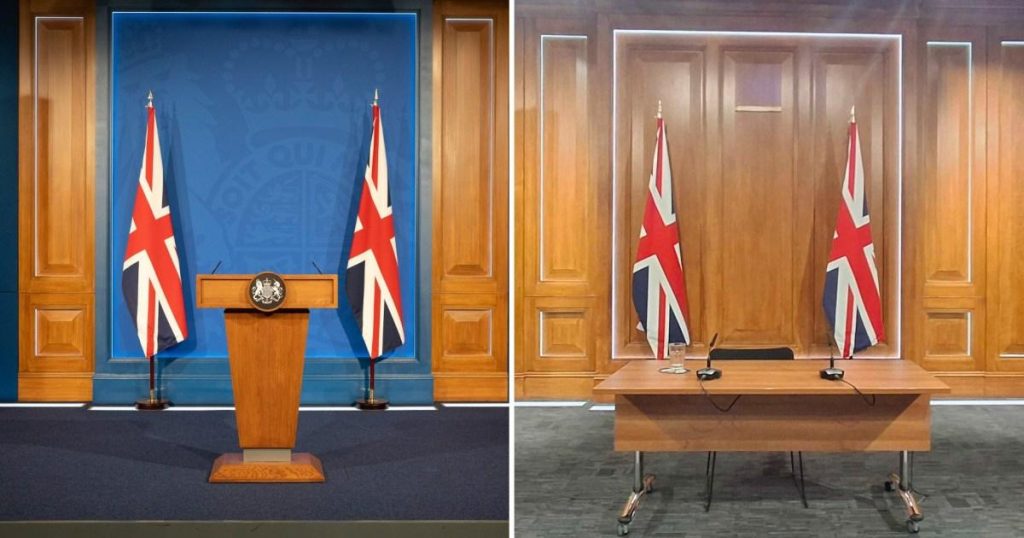The Downing Street press briefing room has undergone a transformation, shedding its distinctive “Tory blue” hue for a more neutral aesthetic. Initially conceived and constructed during Boris Johnson’s premiership amidst the COVID-19 pandemic, the room’s vibrant blue backdrop, featuring a subtle nod to the UK’s Coat of Arms, has been replaced with wood panelling and a subdued grey carpet. This redecoration, completed during the parliamentary Christmas recess, has sparked discussion about its cost and political implications. While the exact figure remains undisclosed pending the release of the Cabinet Office’s annual accounts, estimates place the refurbishment at approximately £80,000.
This recent renovation marks a significant departure from the room’s previous incarnation, a £2.6 million project initiated by the Johnson government. Intended as a dedicated space for COVID-19 press conferences, the original briefing room quickly became embroiled in controversy. The infamous “Partygate” scandal, triggered by a leaked video of then-press secretary Allegra Stratton jokingly discussing Christmas festivities during lockdown, cast a shadow over the room’s purpose and cemented its association with the Johnson administration. The subsequent change in government, coupled with the desire for a more neutral setting, prompted the recent refurbishment.
The shift in aesthetic, from the bold blue to a more understated grey, has been interpreted as an attempt to distance the current administration from its predecessor. Sir Keir Starmer’s spokesperson emphasized the “one-off refresh” as a means of restoring the room to a politically neutral state, highlighting its return to its original condition. The spokesperson also underscored the significantly lower cost of the recent refurbishment compared to the initial construction, emphasizing the fiscal responsibility of the current government. This narrative of fiscal prudence aligns with the government’s broader message of reducing spending on communications and campaigns.
The redecoration of the briefing room also signals a change in its usage. While previously utilized primarily by the Prime Minister for COVID-19 updates, the revamped space is now intended to host press conferences by Sir Keir Starmer, marking a shift in the political landscape. This increased visibility for the Labour leader underscores the government’s commitment to transparency and open communication. The decision to utilize the existing space, rather than construct a new facility, further reinforces the government’s emphasis on fiscal responsibility.
The controversy surrounding the briefing room highlights the symbolic importance of such spaces in political discourse. The initial investment of £2.6 million under the Johnson government, criticized by the Labour party as a “vanity project,” became a symbol of perceived excess and detachment from public concerns. The subsequent redecoration, presented as a return to neutrality and fiscal responsibility, reflects the current government’s attempt to reshape its public image. The briefing room, therefore, serves as a microcosm of the broader political narrative, reflecting the ongoing dialogue between opposing parties and their respective priorities.
In conclusion, the transformation of the Downing Street briefing room represents more than just a cosmetic change. It signifies a shift in political leadership, a re-evaluation of priorities, and a renewed focus on fiscal responsibility. The contrasting aesthetics, from the vibrant blue of the Johnson era to the subdued grey of the current administration, symbolize a departure from the past and a commitment to a new political direction. The briefing room, once a backdrop for controversy, has been recast as a symbol of transparency and a platform for future political discourse. The reduced cost of the recent renovation, compared to the initial construction, underscores the government’s emphasis on fiscal prudence and its commitment to responsible spending. The room’s renewed purpose as a venue for Sir Keir Starmer’s press conferences further emphasizes the government’s commitment to open communication and its recognition of the evolving political landscape.


